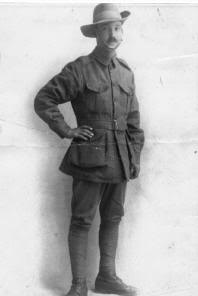Adolf Leopold Drager
| Alias | Adolph Leopold |
|---|---|
| Born | 13.05.1892 |
| Place | Riga, Latvia |
| Ethnic origin | German / Latvian |
| Religion | Church of England |
| Father | Randolf (Rendolf) Drager |
| Mother | Helena |
| Family | Brothers Ernest Mikel Dreger and Frederick William Draeger; wife Mary Ellen Drager (née Armstrong), married 1923; children Shirley b.1926, Brian b.1931, Dalys b. 1936 |
| Contacts | [August Maren](../JohnsonPeter) |
| Arrived at Australia |
from Russia via London on 7.03.1911 per Otway disembarked at Fremantle |
| Residence before enlistment | Doodlakine, Bayswater, Perth; Culham, Toodyay, WA |
| Occupation | Hairdresser, barber |
| Naturalisation | 1914 |
| Residence after the war | Fremantle, Perth |
| Died | 14.02.1970, Perth |
Service #1
| Service number | 3506 |
|---|---|
| Enlisted | 27.09.1915 |
| Place of enlistment | Perth |
| Unit | 28th Battalion, 51st Battalion |
| Rank | Private |
| Place | Western Front, 1916-1918 |
| Casualties | WIA 1916, 1917, 1918 (left leg amputated) |
| Final fate | RTA 24.03.1919 |
| Discharged | 20.07.1920 |
Materials
Digitised naturalisation (NAA)
Digitised service records (NAA)
Digitised Embarkation roll entry (AWM)
Personal case file 1 2 (NAA)
Blog article
Publications
F. G. Clarke , Will-o'-the-wisp. Peter the Painter and the anti-tsarist terrorists in Britain and Australia, Melbourne, Oxford University Press, 1983.
Elena Govor, Latvian Anzacs. In: Aldis L. Putniņš, ed., Early Latvian Settlers in Australia, Melbourne: Sterling Star, 2010, pp. 16-52.
Newspaper articles
Alleged attempted suicide. - The West Australian, Perth, 20 June 1922, p. 6.
Adolph Leopold Drager. - The West Australian, Perth, 21 June 1922, p. 6.
Attempted suicide. - The West Australian, Perth, 26 September 1922, p. 8.
North Perth collision. - The West Australian, Perth, 27 October 1949, p. 2.
One-legged driver not negligent. - The Daily News, Perth, 6 November 1950, p. 8.
From Russian Anzacs in Australian History:
Among other casualties [in spring 1918] there was Ernest Dreger's brother, Adolf Leopold Drager, wounded for the third time: this time he lost his leg. His niece Elaine Dreger tells how she remembers her father Ernest and her Uncle Fred talking about her Uncle Dolph losing his leg: 'As I recall, after the incident the medical team went through but Uncle Dolph was thought to be dead. On the third day the Salvation Army were still looking for survivors, and finding Dolph still alive brought him back. The leg had become fly blown but this was said to have saved his life because the maggots had eaten the rotten flesh and saved the wound from becoming gangrenous. Unfortunately, he had to be operated on three times so that finally he had a very high amputation.'
Gallery

Adolf Leopold Drager
courtesy of Drager's family
 Russian Anzacs
Russian Anzacs